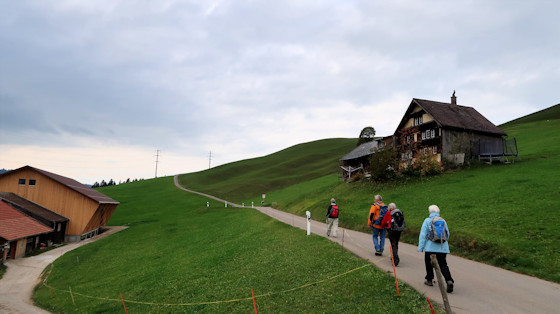After crossing Wattwil - partly along the Thur - the path leads steeply uphill again to Iberg Castle. On a board there you can read the history (shortened):
 It is not surprising that the Counts of Toggenburg and the abbots of the
monastery of St. Gallen, whose landed estates were colorfully mixed, often faced each other as rivals. Around the year 1240, the abbot had a castle built above Wattwil by his
then servant from the Iberg family. At that time, the fortress Iberg was supposed to secure the extremely important pass crossings over the Ricken and the Laad and thus the
rights of the abbot and to supervise every warlike action of the count. Hardly had the work been completed when Count Kraft I attacked the fortress. In order to bring the Iberg
back into his hands, the abbot built around 1253 on the eastern side of the valley, in the forest wilderness of Pfanneregg (on the way from Thurtal via Hemberg to Appenzell,
which at that time was still an abbey) the fortress of Bärenfels. Already in 1259 the abbot retook the castle Iberg. Later on, the abbots and the count's house fought several
times over the possession of the Iberg and the hotly contested fortress was also surrounded by other war events.
It is not surprising that the Counts of Toggenburg and the abbots of the
monastery of St. Gallen, whose landed estates were colorfully mixed, often faced each other as rivals. Around the year 1240, the abbot had a castle built above Wattwil by his
then servant from the Iberg family. At that time, the fortress Iberg was supposed to secure the extremely important pass crossings over the Ricken and the Laad and thus the
rights of the abbot and to supervise every warlike action of the count. Hardly had the work been completed when Count Kraft I attacked the fortress. In order to bring the Iberg
back into his hands, the abbot built around 1253 on the eastern side of the valley, in the forest wilderness of Pfanneregg (on the way from Thurtal via Hemberg to Appenzell,
which at that time was still an abbey) the fortress of Bärenfels. Already in 1259 the abbot retook the castle Iberg. Later on, the abbots and the count's house fought several
times over the possession of the Iberg and the hotly contested fortress was also surrounded by other war events.
The history of the decay of Iberg begins around 1710 with the turmoil before the Toggenburg War. At the beginning of the 18th century,
feudatories settled in the castle and the fortress became a farmhouse and inn. Since no one took care of the maintenance of the building, its inhabitants moved away from the
damaged building at the beginning of the last century and the castle stood empty for about two decades. And - as we read in the history written by chaplain Kobler about the
Iberg - then came the black day, when Jakob Schwander's lack of understanding and the indifference of his fellow citizens turned the once so proud fortress into a desolate heap
of ruins. In 1835, factory owner Schwander had the enormous roof truss demolished and all the wood and bricks taken away, furious that the community rejected his proposal to
take over the castle as a poorhouse. Defencelessly exposed to the weather, the walls crumbled. In 1883 the castle ruins became the property of the municipality by donation.
Today, the tower rebuilt in 1902 on a splendid hill west of the village reminds of the past, eventful times.



Castle keep, balcony, view towards Laadpass - course of the Way of St. James
View from the castle Iberg: In the background the still snow-covered Churfirsten

Ascent to the Laad Pass (October 2017)
The climb ends at the Laad Pass (Heid 990 m)
The "Heid" marks the highest point of the Laad crossing between Thurtal and Lindthgebiet. A wayside shrine invited travelers and pilgrims to rest and pray.
From now on it's downhill ...
... to the village Walde with a baroque parish church St. Antonius (built 1836/37)



When we reach Rüeterswil lake Zurich appears. Rapperswil and the lake dam are recognizable.

Cross in a garden full of dalia

autumn view
This beautiful statue of St. James is in the chapel in Rüeterswil, which we visited, of course.

The chapel is dedicated to St. Ursula. The picture behind the altar shows her with her companions.
She is the city saint of Cologne.

On the way to Sankt Gallenkappel
Shortly after, we reach St. Gallenkappel. We visit the baroque Grubenmann Church.
Inside it looks very baroque. The two figures on the altar (center) are Laurentius and Gallus.


Way from St. Gallenkappel to Neuhaus
There is a chapel of St. James in Neuhaus

In front of the chapel this board informs about the further variants of the path:
- via Schmerikon - Tuggen - Siebenen - Galgenen to Einsiedeln
- via Eschenbach - Rapperswil - Pfäffikon to Einsiedeln

previous stage Appenzell Way |
Appenzell Way |
